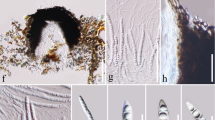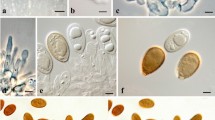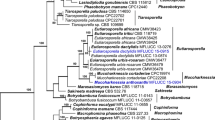Summary
Collections of three fungal species described from Germany by Alexander von Humboldt have been rediscovered in the mycological herbarium at Kew. These collections are considered lectotypes of Boletus patella, B. venosus, and Clavaria aurea and are assigned to Postia stiptica, Physisporinus vitreus, and Calocera viscosa respectively. Humboldt’s Central & South American collections are also at Kew and a list of specimens is appended. Based on the rediscovered type collection, Favolus humboldtii is considered a synonym of Polyporus tenuiculus.
Similar content being viewed by others
References
Berkeley, M. J. (1839). Descriptions of exotic fungi in the collection of Sir W. J. Hooker, from memoirs and notes of J. F. Klotzsch, with additions and corrections. Ann. Nat. Hist. 3: 376 – 401.
Cunningham, G. H. (1965). Polyporaceae of New Zealand. Bull. New Zealand Dept. Sci. Industr. Res. 164: 1 – 304.
Fidalgo, M. E. P. K. (1968). The genus Hexagonia. Mem. New York Bot. Gard. 17: 35 – 108.
Fries, E. M. (1821). Systema Mycologicum 1. Greifswald, Berlin.
____ (1838). Epicrisis systematis mycologi. Typographia Academica, Uppsala.
____ (1851). Novae symbolae mycologicae. Nova Acta Regiae Soc. Sci. Upsal., Ser. 3, 1: 17 – 136.
Greville, R. K. (1824). Scottish cryptogamic flora 2. Maclachlan & Stewart, Edinburgh.
____ (1825). Flora Edinensis. William Blackwood, Edinburgh.
Hawksworth, D. L. (1988). A new name for Dictyonema pavonium (Swartz) Parmasto. Lichenologist 20: 101.
Humboldt, F. A. von (1793). Florae Fribergensis Specimen. H. A. Rottmann, Berlin.
Jülich, W. (1982). Notes on some Basidiomycetes (Aphyllophorales and Heterobasidiomycetes). Persoonia 11: 424 – 428.
Karsten, P. A. (1889). Kritisk öfversigt af Finlands Basidsvampar (Basidiomycetes; Gastero- och Hymenomycetes). Bidr. Känn. Finl. Nat. Folk 48: 1 – 470.
Kreisel, H. (1971). Clave para la identificacion de los macromicetos de Cuba. Ciencias (Havana), Ser. 4, 16: 1 – 101.
Kunth, C. S. (1822). Synopsis Plantarum 1. Paris.
Linnaeus, C. von (1763). Species Plantarum 2, 2. Holmiae.
Morgan, A. P. (1889). North American Fungi. J. Cincinnati Soc. Nat. Hist. 12: 8 – 22.
Murrill, W. A. (1904). The Polyporaceae of North America – VIII. Hapalopilus, Pycnoporus, and new monotypic genera. Bull. Torrey Bot. Club 31: 415 – 428.
Nees von Esenbeck, C. G. (ed.) (1820). Horae Physicae Berolinenses. A. Marcus, Bonn.
Núñez, M. & Ryvarden, L. (1995). Polyporus (Basidiomycotina) and related genera. Syn. Fungorum 10: 1 – 85.
Patouillard, N. (1900). Essai taxon. L. Declume, Lons-le-Saunier.
Persoon, C. H. (1801). Synopsis methodica fungorum. Göttingen.
Ryvarden, L. (1972). A critical checklist of the Polyporaceae in tropical East Africa. Norweg. J. Bot. 19: 229 – 238.
____ (1976). Type studies in the Polyporaceae, 7. Species described by J. M. (sic) Berkeley from 1836 to 1843. Kew Bull. 31: 81 – 103.
____ (1978). The Polyporaceae of North Europe. 2. Fungiflora, Oslo.
____ (1991). Genera of polypores. Syn. Fungorum 5: 1 – 363.
Saccardo, P. A. (1882). Sylloge Fungorum 1. Padua.
Schaeffer, J. C. (1763). Fungorum qui in Bavaria et Palatinatu 2. Erlangen.
____ (1774). Fungorum qui in Bavaria et Palatinatu 4. Erlangen.
Swartz, O. (1806). Flora Indiae Occidentalis. 3. Erlangen.
Thor, G. (1991). The lichen genus Chiodecton and five allied genera. Opera Bot. 1 – 92.
Acknowledgements
Thanks to Dr Jean Mouchacca (PC) and Dr Robert Vogt (B) for correspondence concerning possible Humboldt herbarium material at Paris and Berlin.
Author information
Authors and Affiliations
Corresponding author
Rights and permissions
About this article
Cite this article
Roberts, P. Alexander von Humboldt’s fungal collections at Kew. Kew Bull 66, 191–194 (2011). https://doi.org/10.1007/s12225-011-9270-3
Accepted:
Published:
Issue Date:
DOI: https://doi.org/10.1007/s12225-011-9270-3




